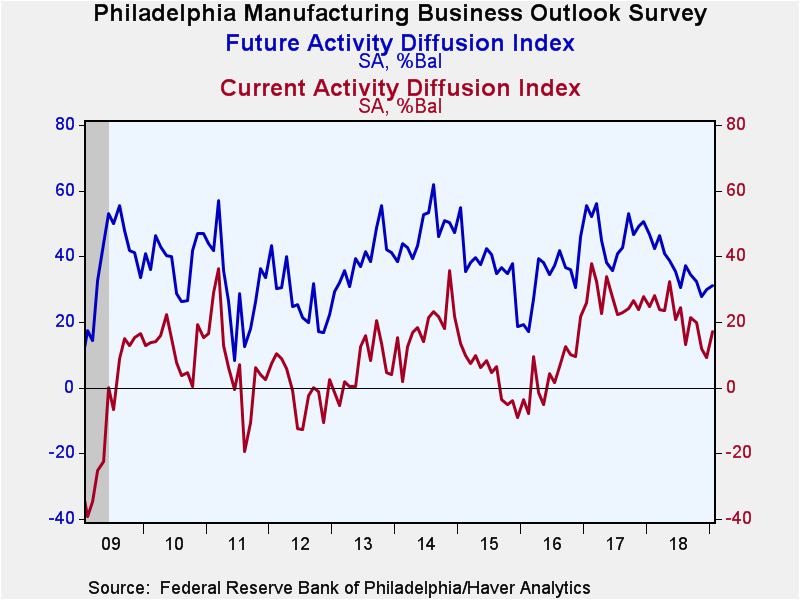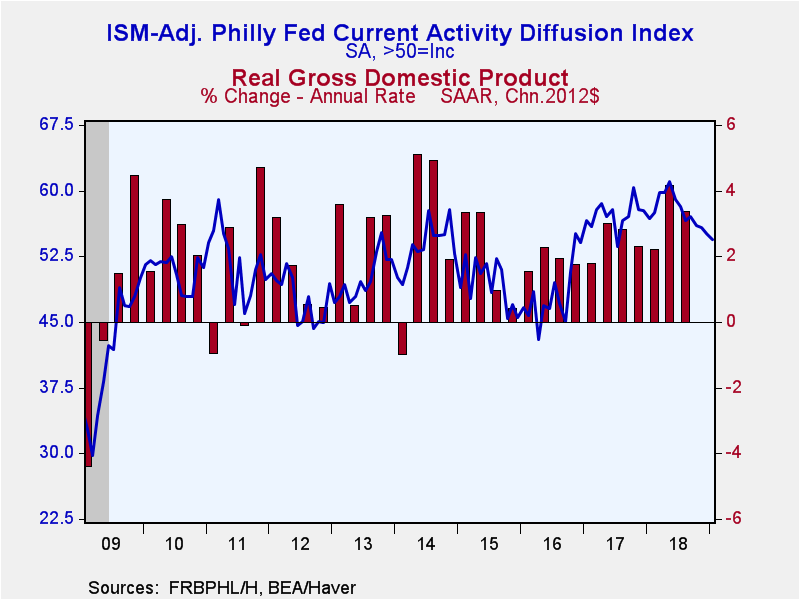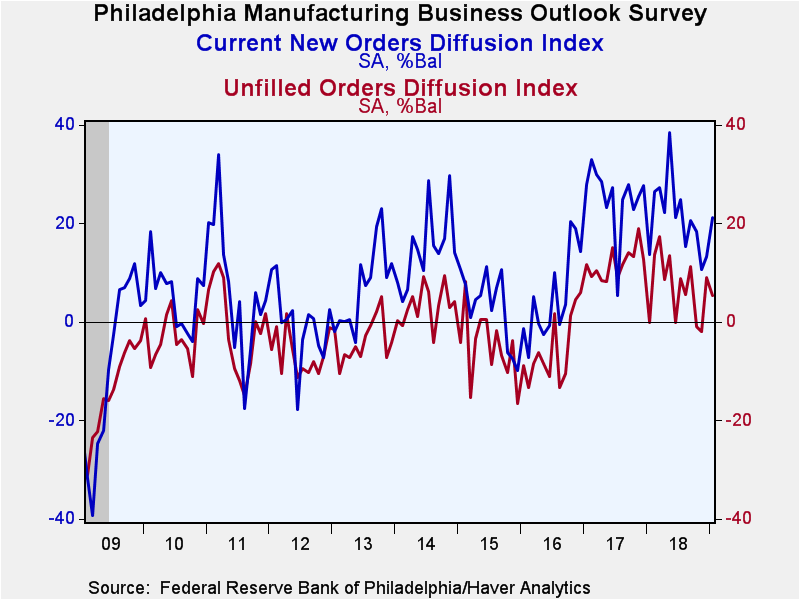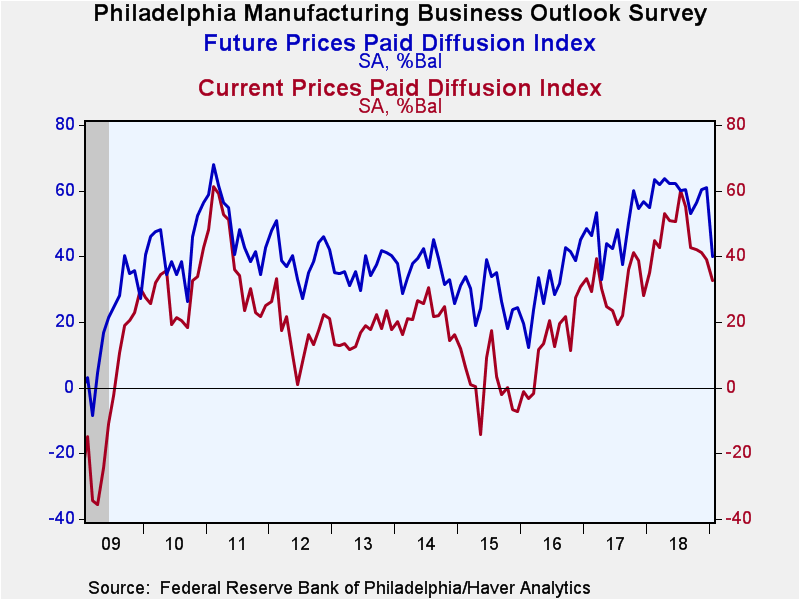 Global| Jan 17 2019
Global| Jan 17 2019Philadelphia Fed Manufacturing Index Rebounds; Pricing Pressure Eases
by:Tom Moeller
|in:Economy in Brief
Summary
The Philadelphia Federal Reserve reported that its General Factory Sector Business Conditions Index increased to 17.0 during January, the highest level in three months. The Action Economics Forecast Survey median estimate was 10.0. [...]
The Philadelphia Federal Reserve reported that its General Factory Sector Business Conditions Index increased to 17.0 during January, the highest level in three months. The Action Economics Forecast Survey median estimate was 10.0. These figures are diffusion indexes where readings above zero indicate expansion. The percentage of firms reporting an improvement in business activity increased to 30%, but remained down from the high of 47% in May of 2018. The number reporting a weakening environment fell to 13%, the lowest level since May of last year.
Haver Analytics constructs an ISM-Adjusted General Business Conditions Index and it declined to 54.4 in January and has been trending lower since it reached a cycle high of 61.1 in May of last year. During the last ten years, there has been a 58% correlation between the quarterly ISM-adjusted Philadelphia Fed Index and quarterly real GDP growth.
Movement amongst the component readings was mixed this month. Showing improvement were the new orders, delivery times and average workweek series. The shipments, unfilled orders and inventories series worked lower.
The employment index declined sharply to the lowest level since September 2017. During the last ten years, there has been a 78% correlation between the employment index and the month-to-month change in factory sector payrolls. Twenty-two percent of respondents reported increased hiring, down from last year's high of 35%. A higher 13% indicated a decrease in hiring, up from none in October 2017. The average workweek reading improved slightly but remained near a two-year low. The index of future employment has been trending higher recently, but remains well below its May high.
The index of prices paid declined sharply to the lowest point since December 2017, and the prices received index also weakened modestly. Thirty-three percent of firms reported higher prices paid while seven percent paid less. The future prices paid index collapsed to the lowest point in nearly two years.
The index measuring expectations of future business conditions improved m/m, but remained well below its high early in 2017.
The survey panel consists of 150 manufacturing companies in the third Federal Reserve District (which consists of southeastern PA, southern NJ and Delaware). The diffusion indexes represent the percentage of respondents indicating an increase minus the percentage indicating a decrease in activity. The ISM-adjusted figure, calculated by Haver Analytics, is the average of five diffusion indexes: new orders, shipments, employment, delivery times and inventories with equal weights (20% each). Each ISM-adjusted index is the sum of the percent responding "higher" and one-half of the percent responding "same."
The figures from the Philadelphia Federal Reserve dating back to 1968 can be found in Haver's SURVEYS database. The expectation from the Action Economics Forecast Survey is available in AS1REPNA.
The latest Beige Book from the Federal Reserve covering regional economic conditions is available here.
| Philadelphia Fed - Manufacturing Business Outlook Survey (%, SA) | Jan | Dec | Nov | Jan'18 | 2018 | 2017 | 2016 |
|---|---|---|---|---|---|---|---|
| General Factory Sector Business Conditions | 17.0 | 9.1 | 11.9 | 24.8 | 21.1 | 27.3 | 4.9 |
| ISM-Adjusted Business Conditions | 54.4 | 55.1 | 55.8 | 56.8 | 57.7 | 57.3 | 48.2 |
| New Orders | 21.3 | 13.3 | 10.6 | 13.7 | 21.0 | 25.3 | 5.0 |
| Shipments | 11.4 | 12.4 | 19.8 | 27.7 | 22.8 | 26.8 | 6.9 |
| Unfilled Orders | 5.4 | 9.1 | -2.0 | -0.1 | 7.1 | 11.9 | -5.6 |
| Delivery Time | 13.4 | 5.5 | 6.1 | 7.1 | 9.5 | 10.6 | -4.6 |
| Inventories | -7.6 | 2.6 | 7.3 | 7.1 | 7.4 | 2.9 | -9.6 |
| Number of Employees | 9.6 | 19.1 | 17.7 | 18.3 | 21.6 | 16.1 | -5.6 |
| Average Workweek | 6.0 | 4.0 | 7.9 | 15.6 | 15.9 | 14.9 | -5.4 |
| Prices Paid | 32.7 | 38.9 | 41.2 | 35.0 | 46.4 | 30.4 | 13.5 |
| Expectations - General Business Conditions; Six Months Ahead | 31.2 | 29.9 | 27.9 | 46.7 | 36.9 | 47.1 | 33.7 |
Tom Moeller
AuthorMore in Author Profile »Prior to joining Haver Analytics in 2000, Mr. Moeller worked as the Economist at Chancellor Capital Management from 1985 to 1999. There, he developed comprehensive economic forecasts and interpreted economic data for equity and fixed income portfolio managers. Also at Chancellor, Mr. Moeller worked as an equity analyst and was responsible for researching and rating companies in the economically sensitive automobile and housing industries for investment in Chancellor’s equity portfolio. Prior to joining Chancellor, Mr. Moeller was an Economist at Citibank from 1979 to 1984. He also analyzed pricing behavior in the metals industry for the Council on Wage and Price Stability in Washington, D.C. In 1999, Mr. Moeller received the award for most accurate forecast from the Forecasters' Club of New York. From 1990 to 1992 he was President of the New York Association for Business Economists. Mr. Moeller earned an M.B.A. in Finance from Fordham University, where he graduated in 1987. He holds a Bachelor of Arts in Economics from George Washington University.










